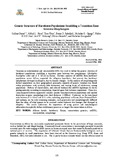| dc.description.abstract | Variation in mitochondrial and microsatellite DNA was used to define the genetic structure of
hartebeest populations straddling a transition zone between two morphotypes (Alcelaphus
buselaphus cokei and A. b. lelwel) in Kenya. Previous analyses of mtDNA from hartebeest
populations across Africa supported the refugium hypothesis; that present day hartebeest
morphotypes diverged in allopatry, due to climatic changes. In this analysis of morphologically
distinct populations in close geographical proximity, majority of genetic variation was found
within populations, with relatively little distinction, and varying levels of subdivision, among
populations. Patterns of shared alleles, and reduced tendency for mtDNA haplotypes to cluster
phylogenetically according to morphotype, depicted gene flow between populations. There was
sharp disparity between apparently seamless genetic transition between populations and marked
disjunction in gross morphology over short distances (<100km). Hartebeest in the transitional
zone between A. b. lelwel and A. b. cokei, including populations in Ruma, Meru National Parks
and Laikipia, are the only remaining examples, each genetically and morphologically different
from the other, of what appears to be resumed contact between two lineages that diverged in
allopatry. Our results underscore the importance of using genetic and morphological
information to explicitly define evolutionary processes as targets for conservation in Africa. | en |

